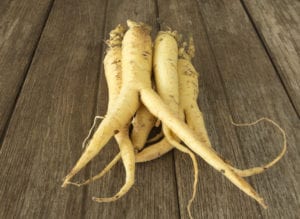Written by Greg Arnold, DC, CSCS. Participating healthy male runners found that a combination of panax ginseng and danshen, taken daily for 7 days prior to downhill running, significantly improved their muscle damage and arterial stiffness and significantly increased their range of motion as well, compared to the runners in the control group.
 Panax ginseng is one of the most popular Chinese herbs, dating back thousands of years 1. The major components of ginseng, ginsenosides, are thought to protect blood vessels by scavenging free radicals 2 and increasing nitric oxide production 3. Another Chinese herb, danshen, has also been shown to improve circulation 4 and scavenge free radicals 5. Because of these health-promoting properties, Panax ginseng and danshen are often mixed in herb formulas in Chinese medicine in the hope they act together (“synergistically”) to promote health 6.
Panax ginseng is one of the most popular Chinese herbs, dating back thousands of years 1. The major components of ginseng, ginsenosides, are thought to protect blood vessels by scavenging free radicals 2 and increasing nitric oxide production 3. Another Chinese herb, danshen, has also been shown to improve circulation 4 and scavenge free radicals 5. Because of these health-promoting properties, Panax ginseng and danshen are often mixed in herb formulas in Chinese medicine in the hope they act together (“synergistically”) to promote health 6.
Research now suggests that panax ginseng and danshen together may improve muscle recovery after exercise. A 2016 double-blind, placebo-controlled study 7 involved 23 healthy males aged 21 to 31. They received either 1.75 grams of panax ginseng with 1.75 grams of danshen per day (12 subjects) or a placebo (11 subjects) for 7 days. On day 8, each subject performed a downhill running test. The test consisted of a 5-minute warm-up on the treadmill after which each subject walked or ran while the treadmill slope was increased 1 % every minute until the subjects could not continue the test. The subjects were then followed for the next 72 hours.
The researchers noted three significant changes between the two groups:
After 72 hours, those in the ginseng group experienced a 6% significantly greater range of motion of their thigh muscle compared to placebo (105 versus 99 degrees, p < 0.05), indicating less muscle damage from the downhill running.
After 48 hours, those in the ginseng group had a significantly lower increase in creatine kinase levels (190 versus 350% increase, p < 0.05), a marker of decreased muscle damage 8.
After 24 hours, those in the placebo group had a 12.9% higher rate of arterial stiffness (called “carotid-femoral pulse wave velocity” 9 compared to the ginseng group (503 versus 577 centimeters/second, p < 0.05), another marker of increased muscle damage 10.
For the researchers, “A short-term Chinese herb supplementation incorporating panax ginseng and danshen was effective in ameliorating the delayed onset vascular stiffening induced by acute eccentric exercise, possibly via the reductions in oxidative stress and systemic inflammation.”
Source: Lin et al. Panax ginseng and salvia miltiorrhiza supplementation abolishes eccentric exercise-induced vascular stiffening: a double-blind randomized control trial BMC Complementary and Alternative Medicine (2016) 16:168; DOI 10.1186/s12906-016-1139-4
© 2016 The Author(s). Open Access under Creative Commons Attribution 4.0 International License (http://creativecommons.org/licenses/by/4.0/)
Click here to read the full text study.
Posted October 14, 2016.
Greg Arnold is a Chiropractic Physician practicing in Hauppauge, NY. You can contact Dr. Arnold directly by emailing him at PitchingDoc@msn.com or visiting his web site at www.PitchingDoc.com.
References:
- Yue PY, Mak NK, Cheng YK, et al. Pharmacogenomics and the Yin/Yang actions of ginseng: anti-tumor, angiomodulating and steroid-like activities of ginsenosides. Chin Med. 2007;2:6.
- Kang KS, Yokozawa T, Kim HY, Park JH. Study on the nitric oxide scavenging effects of ginseng and its compounds. J Agric Food Chem. 2006;54(7):2558-2562.
- Lu JM, Yao Q, Chen C. Ginseng compounds: an update on their molecular mechanisms and medical applications. Curr Vasc Pharmacol. 2009;7(3):293-302.
- Han JY, Fan JY, Horie Y, et al. Ameliorating effects of compounds derived from Salvia miltiorrhiza root extract on microcirculatory disturbance and target organ injury by ischemia and reperfusion. Pharmacol Ther. 2008;117(2):280-295.
- Ji XY, Tan BK, Zhu YZ. Salvia miltiorrhiza and ischemic diseases. Acta pharmacologica Sinica. 2000;21(12):1089-1094.
- Liang X, Chen X, Liang Q, et al. Metabonomic study of Chinese medicine Shuanglong formula as an effective treatment for myocardial infarction in rats. Journal of proteome research. 2011;10(2):790-799.
- Lin HF, Tung K, Chou CC, Lin CC, Lin JG, Tanaka H. Panax ginseng and salvia miltiorrhiza supplementation abolishes eccentric exercise-induced vascular stiffening: a double-blind randomized control trial. BMC Complement Altern Med. 2016;16:168.
- Barnes JN, Trombold JR, Dhindsa M, Lin HF, Tanaka H. Arterial stiffening following eccentric exercise-induced muscle damage. Journal of applied physiology (Bethesda, Md : 1985). 2010;109(4):1102-1108.
- Tanaka H, DeSouza CA, Seals DR. Absence of age-related increase in central arterial stiffness in physically active women. Arterioscler Thromb Vasc Biol. 1998;18(1):127-132.
- Burr JF, Boulter M, Beck K. Arterial stiffness results from eccentrically biased downhill running exercise. Journal of science and medicine in sport. 2015;18(2):230-235.
